Kirkcudbright
Kirkcudbright (/kərˈkuːbri/ kur-KOO-bree; Scottish Gaelic: Cille Chuithbeirt) is a town and parish and a Royal Burgh from 1455 in Kirkcudbrightshire, of which it is traditionally the county town, within Dumfries and Galloway, Scotland.
Kirkcudbright
| |
|---|---|
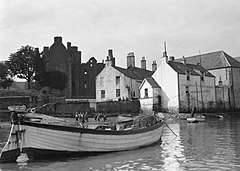 Kirkcudbright | |
 Kirkcudbright Location within Dumfries and Galloway | |
| Population | 3,352 (2011) |
| OS grid reference | NX685505 |
| • Edinburgh | 84 mi (135 km) |
| • London | 282 mi (454 km) |
| Council area | |
| Lieutenancy area | |
| Country | Scotland |
| Sovereign state | United Kingdom |
| Post town | KIRKCUDBRIGHT |
| Postcode district | DG6 |
| Dialling code | 01557 |
| Police | Scotland |
| Fire | Scottish |
| Ambulance | Scottish |
| UK Parliament | |
| Scottish Parliament | |
The town lies southwest of Castle Douglas and Dalbeattie at the mouth of the River Dee, around 4 miles (6.4 km) from the Irish Sea.
History
An early rendition of the name of the town was Kilcudbrit;[2] this derives from the Gaelic Cille Chuithbeirt meaning "chapel of Cuthbert", the saint whose mortal remains were kept at the town between their exhumation at Lindisfarne and reinterment at Chester-le-Street.[3]
John Spottiswoode, in his account of religious houses in Scotland, mentions that the Franciscans, or Grey Friars, had been established at Kirkcudbright from the 12th century.[4] No traces of the Greyfriars or Franciscan dwellings remain in the parish of Kirkcudbright.
John Balliol was in possession of the ancient castle at Castledykes in the late 13th century and Edward I of England is said to have stayed here in 1300 during his war against Scotland.[5]
In 1455 Kirkcudbright became a Royal Burgh.[6] About a century later, the magistrates of the town obtained permission from Queen Mary to use part of the convent and nunnery as a parish church. From around 1570, Sir Thomas MacLellan of Bombie, the chief magistrate, received a charter for the site, its grounds and gardens. MacLellan dismantled the church in order to obtain material for his new castle, a very fine house, which was built on the site.[7]
After defeat at the Battle of Towton, Henry VI of England crossed the Solway Firth in August 1461 to land at Kirkcudbright in support of Queen Margaret at Linlithgow. The town for some time withstood a siege in 1547 from the English commander Sir Thomas Carleton but, after the surrounding countryside had been overrun, was compelled to surrender.[8]
Kirkcudbright Tolbooth was built between 1625 and 1629 and served not only as the tolbooth, but also the council offices, the burgh and sheriff courts, the criminal prison and the debtors' prison. One of the most famous prisoners was John Paul Jones, founder of the United States Navy, who was born in Kirkbean.[9][10]
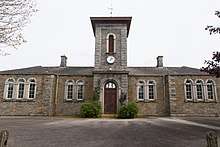
The Johnston School was the town primary school until replaced with a new build in 2009. The school was endowed with a bequest by Kirkcudbright merchant and shipowner William Johnston (1769- 1845) and opened in 1847 as Johnston's Free School. The building was designed by Edinburgh architect James Newlands (1813-1871) who later went on to be the first Borough Engineer for Liverpool where he designed and built the first integrated sewerage system in the world in 1848. The school building was rebuilt, retaining the Italianate tower and façade in 1933 by William A MacKinnell, (1871-1940). He was the County Architect for Kirkcudbrightshire and built many schools in the Stewartry. In 2020 the building is being refurbished as a Community Activity and Resource Centre. The building is Listed Category B.[11][12]
St Andrew's and St Cuthbert's Church was designed in 1886 by London architect A E Purdie (1843-1920), in the Gothic style. It was built on the site of the medieval St Andrew's Church. In 1971 the interior was re-ordered and stripped of its Victorian fixtures and fittings and now features an abstract concrete and iron cross by the Liverpool sculptor Sean Rice (1931-1997), modern stained glass by the Polish artist Jerzy Faczynski (1917-1994) and a set of four paintings by Vivian K Chapman depicting The Passion. The church was built on the site of the old prison and the governor's house now serves as the clergy house. The church was built close to the site of the pre-reformation St Andrews Church.
The Kirkcudbright Railway opened in 1864 but the railway line and station closed in 1965.[13]
The Town Hall was designed by architects Peddie and Kinnear. It was completed in 1879 and is a Category B listed building.[14] It has been converted into the Kirkcudbright Galleries (see below).
The War Memorial dates from 1922 and was created by the sculptor George Henry Paulin.[15]
Kirkcudbright training area
Like many other remote areas during the Second World War, a 4,700-acre (19 km2) area to the southeast of the town and extending to the coast of the Solway Firth, was acquired by the Army in 1942, as a training area for the D-Day invasion.[16][17] The area remains in active use for live-firing exercises. Part of the training area is the Dundrennan Range, a weapons development and testing range. The use of this range for the testing of depleted uranium shells has been controversial.[18][19] The range also contains one of the two surviving A39 Tortoise heavy assault tanks from the six prototypes originally produced. The 32-pdr gun has been removed and the tank is used for target practice. Due to the range's designation as a Site of Special Scientific Interest, removal of the tank to a museum is unlikely.
Museums
Broughton House is an 18th-century town house standing on the High Street. It was the home of Scots impressionist artist Edward Atkinson Hornel between 1901 and his death in 1933. The National Trust for Scotland maintain the house and its contents as a museum of Hornel's life and work.
The Stewartry Museum was founded in 1879 and was at first based in the Town Hall until it became too small to house the collections.[20][21] The collection moved to a purpose-built site. It contains the local and natural history of the Stewartry of Kirkcudbright. Britain's earliest surviving sporting trophy, the Siller Gun,[22] is part of the collection, as are paintings by many local artists.
The Tolbooth building is now used as an arts centre.[23][24][25]
The new Kirkcudbright Galleries was officially opened in July 2018 by the Princess Royal. It is situated in the former Town Hall. On display are paintings by the various artists who lived and worked in the town. There is also a gallery for visiting exhibitions, a cafe and gift shop.
Arts
Kirkcudbright Artists' Town
Kirkcudbright has for long been a centre for visual artists and is now known as "the Artists' Town".[26] The town's roadside signs and logo include a representation of paint on a painter's pallet. Today, painters, textile artists, embroiderers, ceramicists, photographers, etchers, print makers, sculptors, encaustic artists, willow makers and more all work in or around the town.
Kirkcudbright is home to an artists' collective, who have a shop in the town centre, The PA, Professional Artists Collective.[27] Wasps (Working Artists Studio Spaces, Scotland) occupy two linked townhouses, Canonwalls and Claverhouse, in the High Street.[28] It is also a centre in which many artists open their studios during Spring Fling Open Studios.
The Kirkcudbright Arts & Crafts Trail takes place every summer. This four-day event, finishing on the first Monday in August, allows visitors to see artists' studios and visit places that are normally off-limits to visitors.
Galleries
Galleries in Kirkcudbright include Kirkcudbright Galleries, formerly the Town Hall, in St Mary Street. Probably the oldest gallery is The Harbour Cottage Gallery.[29] Others include the Whitehouse Gallery, the Ochre Gallery and the High St Gallery.
Cinema and literature
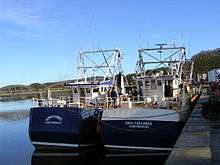
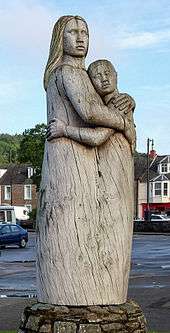
The 1907 novel Little Esson by S.R.Crockett is a romantic mystery involving the artistic community of Kirkcudbright.[30] The title character Archibald Esson is a fictionalised version of William Stewart MacGeorge, Crockett's boyhood friend. The later whodunit Five Red Herrings by Dorothy L. Sayers also involves the artistic community of Kirkcudbright.[31] In 1975, the book was made into a BBC TV film shot in the town, with Ian Carmichael playing the lead role of Lord Peter Wimsey.[32]
The town also provided locations for the cult 1973 horror film The Wicker Man,[33] several parts of the town can be easily recognised in the film.
Robert Urquhart starred in a 1980 BBC adaptation of Ibsen's An Enemy of the People, shot on location in Kirkcudbright.
The 2018 mystery novel The Shadow of the Black Earl by Charles E McGarry has scenes set in Kirkcudbright while most of the action takes place in a fictionalised version of Laurieston Hall and surrounding area.
Music
Matt McGinn wrote and recorded "The Wee Kirkcudbright Centipede" which has also been covered by other singers including Alistair McDonald on disc and on his BBC Scotland show " Songs of Scotland", which included a segment filmed on location at the town's Johnston Primary School where McDonald led the children in a dance sequence.[34][35][36]
The band Betrayal, which comprised Kirkcudbright musician Stephen Milligan (lead guitar), Mervin Macklin (rhythm guitar) and Stephen McClelland (keyboards), as well as Andrew Black (bass), Blue (vocals) and Marty (drums) released an album "Rattlesnake Waltz" on Liverpool's Probe Plus records in 1987. As reviewed in Q magazine at the time as "This seven-piece outfit from Galloway make their album debut with a strange brew containing a healthy dash of speed metal and a fistful of disparate elements taken from early Genesis, The Lovin' Spoonful, Led Zeppelin, and The Skids. On paper this might seem unworkable but in reality it adds up to a highly individual sound, with tracks like Made, Dead Man's Hand and No Big Thing - where Sue Dring's soaring vocals form an attractive contrast to Steve McClelland's manic synthesizer-providing the high spots. The only obvious drawback to this formula is that by utilising such an unusual variety of influences the band may be limiting their appeal to lovers of the eccentric ..."
Notable people
Artists
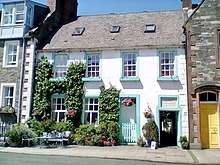
Kirkcudbright has had a long association with the Glasgow art movement. Several artists, including the Glasgow Boys and the famed Scottish Colourists, such as Samuel Peploe and Francis Cadell, based themselves in the area over a 30-year period from 1880 to 1910, establishing the Kirkcudbright Artists' Colony. Also among those who moved here from Glasgow were Edward Hornel, George Henry and Jessie M. King. Later another small group of Glasgow-trained artists built their studios across the river at The Stell, including John Charles Lamont and Robert Sivell. Landscape painter Charles Oppenheimer moved to Kirkcudbright in 1908. He is given credit along with artist Dorothy Nesbitt for protecting the Harbour Cottage (art) Gallery from demolition in 1956. Kirkcudbright became known as "the artists' town",[26] although longtime residents considered it a "fishing town". Other artists include:
- Joseph Simpson (1879–1939) British painter and etcher of portraits and sporting subjects.[37] He worked from a studio at 4 High Street, and rented 14a High Street from E A Hornel (1928 – 1929).
- Phyllis Bone RSA (15 February 1894 – 12 July 1972) was a 20th-century Scottish sculptor. She moved to Galloway and lived in later life in Kirkcudbright.[38]
- Landscape and figure painter William Hanna Clarke lived in Kirkcudbright, and many of his works featured the town. He is buried in the town's churchyard and his tombstone was carved by his friend Alexander Proudfoot, a Glasgow sculptor.[39]
Sportspeople
- Kirkcudbright has been home to some professional footballers, most notably Bob McDougall, George Cloy and David Mathieson.[40][41][42]
- David MacMyn, Scottish rugby international, was from Kirkcudbright.[43]
Others
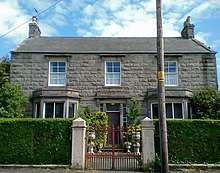
- Malcolm Caldwell, born James Alexander Malcolm Caldwell (1931-1978) was a British academic and a prolific Marxist writer. Caldwell was murdered, under mysterious circumstances, a few hours after meeting Pol Pot in Cambodia. His father, Archibald Thomson Caldwell was County Architect for Kirkcudbrightshire from 1950 until his death in 1957. Caldwell was Dux of Kirkcudbright Academy in 1949.[44]
- Composer Cecil Coles (1888 – 1918), killed on active service in World War I, was born in Kirkcudbright.[45]
- Marriott Edgar, the lyricist and poet who wrote, amongst other things, Albert and the Lion for Stanley Holloway, was born in Kirkcudbright in 1880.
- John Erskine, 1st Baron Erskine of Rerrick.
- T. E. Lawrence (Lawrence of Arabia), lived in infancy with his family between 1889 and 1891 in Craigville, St Mary's Street. His brother William George was born here in 1889.[46] In 1891 the family moved to France.
- Merchant Robert Lenox, father of New York City philanthropist and bibliophile James Lenox, born in New York City on 19 August 1800. His personal collection would give rise to the New York Public Library
- Gary Lewis actor, Gangs of New York, Billy Elliot, etc. lives in Kirkcudbright.
- William (Billy) Marshall (1672-1792) died aged 120, King of the Gypsies. Buried in St Cuthbert's Churchyard.
Sport
Kirkcudbright is represented in the South of Scotland Football League by St Cuthbert Wanderers FC.[47] It was founded by parishioners of St Cuthbert Catholic Church. The club's best-known former players are Bob McDougall, Billy Halliday and David Mathieson.[40]
2019 Tour of Britain
The first stage from Glasgow of the Tour of Britain 2019 ended in Kirkcudbright on 7 September. The winner was Dutchman Dylan Groenewegen.
References
- "Ainmean-Àite na h-Alba (2011) 'Ainmean-Àite na h-Alba - Gaelic Place-Names of Scotland - Database', Ainmean-Aite.org".
- Learmonth, W (2012) Kirkcudbrightshire and Wigtownshire, Cambridgeshire: Cambridge University Press
- Eyre, C (1849) The History of St. Cuthbert: Or an Account of His Life, Decease, and Miracles; of the Wanderings with his Body at Intervals During CXXIV. Years; of the State of his Body from his Decease Until A.D. 1542; and of the Various Monuments Erected to His Memory, City of Westminster: James Burns
- Spottiswood, J (1655) The history of the Church of Scotland, beginning in the year of our Lord 203 and continued to the end of the reign of King James the VI of ever blessed memory : wherein are described the progress of Christianity, the persecutions and interruptions of it, the foundation of churches, the erecting of bishopricks, the building and endowing monasteries, and other religious places, the succession of bishops in their sees, the reformation of religion, and the frequent disturbances of that nation by wars, conspiracies, tumults, schisms : together with great variety of other matters, both ecclesiasticall and politicall, City of London: J. Flesher for R. Royston
- Keay, John (1994). Collins Encyclopedia of Scotland. London: HarperCollinsPublishers. p. 585. ISBN 0002550822.
- Bell, J (2015) 'Old Kirkcudbright - History of an Ancient Parish & Burgh.', Kirkcudbright Community Website.
- Coventry, M (2006) The Castles of Scotland, City of Edinburgh: Birlinn Limited
- Nicolson, J; Burn, R (1777). The History and Antiquities of the counties of Westmorland and Cumberland. 1. City of Westminster.
- Slaving and a Murder Trial. Retrieved 14 November 2012.
- 1770 Extract of Warrant for the arrest of John Paul (Jones). Scan.org.uk. Retrieved 14 November 2012.
- "The Johnston School". Canmore.
- "Johnston School (Former), St Mary Street, Kirkcudbright | Buildings at Risk Register". www.buildingsatrisk.org.uk.
- "Kirkcudbright, St Mary Street, Railway Station". Canmore.
- "Kirkcudbright Public Hall and Museum". Scottish Architects. Retrieved 27 January 2020.
- Edwards, M (2006). "Roll of Honour - Kirkcudbrightshire - Kircudbright".
- "Kirkcudbright Training Area". Ministry of Defence.
- "Secret Scotland - Kirkcudbright Training Area". www.secretscotland.org.uk.
- "Call to stop uranium shell tests". BBC News. 7 February 2001.
- "Weapon test move comes under fire". BBC News. 11 March 2008.
- "The Stewartry Museum". Museums Galleries Scotland. 2015.
- Dumfries and Galloway Council (2105) 'Dumfries and Galloway Council : The Stewartry Museum, Kirkcudbright', Dumfries and Galloway Council. Uniform Resource Locator: "Archived copy". Archived from the original on 25 June 2015. Retrieved 24 June 2015.CS1 maint: archived copy as title (link)
- Bell, J (2015) 'Kirkcudbright's Siller (Silver) Gun', Kirkcudbright Community Website. Uniform Resource Locator: Siller Gun Archived 27 September 2006 at the Wayback Machine. Old-kirkcudbright.net. Retrieved 22 June 2011.
- Tolbooth Arts Centre. Kirkcudbright.co.uk. Retrieved 22 June 2011.
- Dumfries and Galloway Council (2015) 'Dumfries and Galloway Council : Tolbooth Art Centre, Kirkcudbright', Dumfries and Galloway Council. Uniform Resource Locator: "Archived copy". Archived from the original on 24 June 2015. Retrieved 24 June 2015.CS1 maint: archived copy as title (link)
- "Tolbooth Art Centre - Kirkcudbright". Visit Scotland. 2015.
- Artists' Town official website. Kirkcudbright. Retrieved 22 June 2011.
- "The PA Pop-up". PA Pop-up. Retrieved 26 January 2020.
- "WASPS Studios". WASPS Studios. Retrieved 26 January 2020.
- "History – Harbour Cottage Gallery". Retrieved 28 January 2020.
- Donaldson, Islay Murray (2016). The Life and Work of S.R. Crockett. Ayton Publishing. pp. 299, 344. ISBN 9781910601143.
- "Five Red Herrings" – via www.imdb.com.
- "Five Red Herrings (TV Mini-Series 1975)". IMDb.com.
- "Where was 'The Wicker Man' filmed?". British Film Locations. Retrieved 5 June 2017.
- "Scotslanguage.com - The Wee Kirkcudbright Centipede". www.scotslanguage.com. Retrieved 5 September 2019.
- "The Sounds of Scotland". The Radio Times (2753). 12 August 1976. p. 14. ISSN 0033-8060. Retrieved 6 September 2019.
- "The Wee Kirkcudbright Centipede, TV fame and Andy Stewart: breakfast with Alastair McDonald". HeraldScotland. Retrieved 6 September 2019.
- "Joseph W Simpson | Kirkcudbright Galleries | Dumfries and Galloway | Artists | Gallery". Kirkcudbright Galleries.
- "Phyllis Mary Bone (1894 – 1972)". University of Edinburgh Alumni. University of Edinburgh. Retrieved 26 January 2020.
- "William Hanna Clarke". Artists' Footsteps.
- McCartney, I (2008) Queen of the South: The History 1919–2008, Staffordshire: The Breedon Books Publishing Company Limited
- McLean, K (2009). QosFC: Legends - George Cloy. Queen of the South Football Club.
- McLean, K (2009). QosFC: Legends - Tommy Bryce. Queen of the South Football Club.
- HG (1978) 'Obituary', British Medical Journal, 1 (6119, April), 1058 to 1060
- "Caldwell".
- "Comprehensive Report". Commonwealth War Graves Commission. 1918.
- "Life story: William George Lawrence | Lives of the First World War". livesofthefirstworldwar.iwm.org.uk. Retrieved 30 January 2020.
- "St Cuthbert Wanderers FC". St Cuthbert Wanderers FC. 2014.
External links
| Wikimedia Commons has media related to Kirkcudbright. |
- Visit Kirkcudbright Website
- Kirkcudbright Community Website
- http://www.kirkcudbrightacademy.website/caldwell.html
- https://www.independent.co.uk/news/people/obituary-sean-rice-1283255.html
- https://www.ed.ac.uk/alumni/services/notable-alumni/alumni-in-history/phyllis-mary-bone
- https://www.kirkcudbright.town/arts/kirkcudbright-artists-town/
- https://www.kirkcudbrightgalleries.org.uk/artists-footsteps/artist/joseph-w-simpson/
- https://papop-up.co.uk/kirkcudbright/
- https://www.waspsstudios.org.uk/spaces/artist-space/canonwalls-and-claverhouse/
- https://www.cwgc.org/find-war-dead/casualty/320810/LAWRENCE,%20WILLIAM%20GEORGE